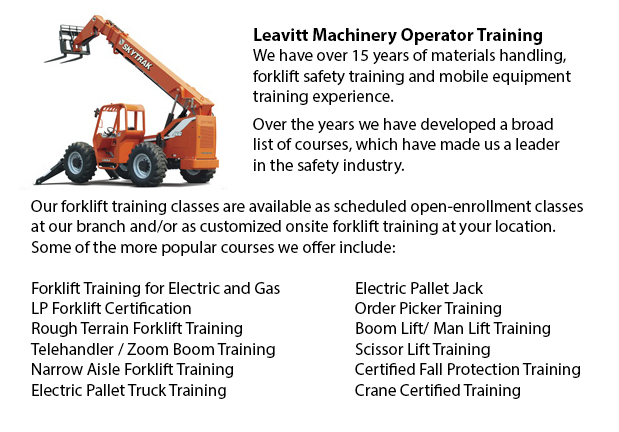
Zoom Boom Training Red Deer - Zoom Boom Training focuses on properly training potential operators on variable reach forklifts. The training objectives consist of gaining the understanding of the machine's physics and to be able to define the tasks of the operator. This program abides by North American safety standards for lift trucks. Zoom boom training and certification is obtainable at the company's location or at our site, provided there are a minimum number of trainees. Certification received upon successfully completing it is valid for three years.
A telescopic handler (likewise called a telehandler) is similar in some ways to both a forklift and a crane. It is a versatile machine made with a telescopic boom which can lift upwards and extend forward. Different attachments could be fitted on the end of the boom, like for example bucket, pallet forks, lift table or muck grab. It is popular in industry and agriculture settings.
The telehandler is a common used with fork attachments in order to enable the transporting of loads. Telehandlers have the advantage of being able to reach those inaccessible places which cannot be reached by a standard forklift. Telehandlers are capable of removing loads which are palletized from inside a trailer and putting them on places which are high such as rooftops. For some applications, they can be more efficient and practical compared to a crane.
When lifting loads that are heavy, the telehandler may experience some unsteadiness. As the boom is extended too far with a load, the machinery will become more unstable. Counterweights in the rear help, but do not solve the problem. As the working radius increases, the lifting capacity quickly decreases. Various machines come together with front outriggers that extend the lifting capacity when the machinery is stationary.
To know whether a load is extremely heavy, the operator could check with the load chart. The factors covered in the calculation consists of boom angle and height and load weight are calculated. Some telehandlers have sensors that cut off further control or provide a warning if the unit is in danger of destabilizing.
-
Fall Protection Ticket Red Deer
Fall Protection Ticket Red Deer - The number one reason of death in the construction industry come from fall-related incidents. There is more possibility for fall accidents depending upon the kinds of work being done in your workplace. Therefore, kno... More -
Overhead Crane Certification Red Deer
Overhead Crane Certification Red Deer - The overhead crane certification course is a course that is designed to help trainees, even if they have language or literacy limitations. The course comprises a practical hands-on training session and a classr... More -
Wheel and Track Loader Training in Red Deer
Lift trucks are obtainable in a variety of various models which have various load capacities. Nearly all typical lift trucks utilized in warehouse settings have load capacities of 1-5 tons. Bigger scale models are utilized for heavier loads, like for... More -
Heavy Equipment Certification Red Deer
Heavy Equipment Certification Red Deer - Heavy duty vehicles are big pieces of machines which are usually known as heavy equipment. It is a broad term that literally includes whatever big utility vehicle in the area of agricultural and forestry imple... More -
Heavy Equipment Operator Classes Red Deer
Heavy Equipment Operator Classes Red Deer - A person who has the correct training to be able to use a particular kind or piece of machine is referred to as an equipment operator. There are different ways that an equipment operator can become trained... More -
Forklift Training Programs Red Deer
Forklift Training Programs Red Deer - Are you searching for a job as a driver of a forklift? Our regulatory-compliant mobile equipment operator training offers instruction in kinds of lift trucks, pre-shift check, fuel types and dealing with fuels, a... More -
Crane Safety Training Red Deer
Crane Safety Training Red Deer - Both crane driver and their supervisors must know all the potential problems related to the operation of an overhead crane. All over North America, there is legislation which provides rules for the safe inspection, ma... More -
Aerial Lift Training Red Deer
Aerial Lift Training Red Deer - An aerial work platform is a mechanized access platform. This device provides access to otherwise inaccessible places for people or equipment. Likewise called an elevating work platform or aerial device, the machinery... More

Forklift Training Red Deer
TOLL FREE: 1-888-254-6157
Red Deer, Alberta
forklifttrainingreddeer.com
Email Us
About Us


